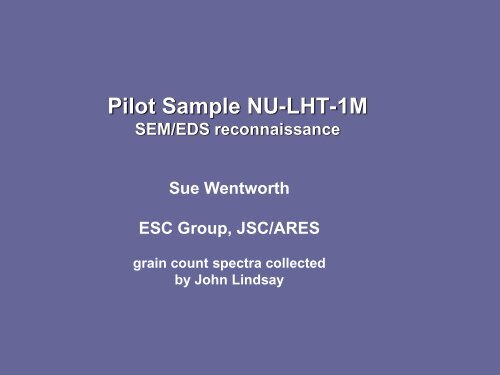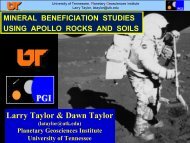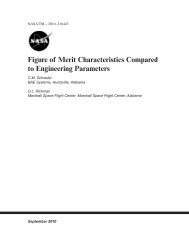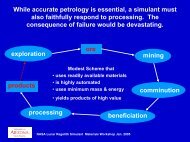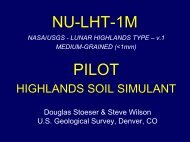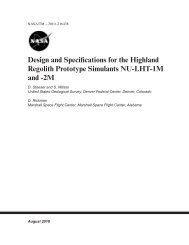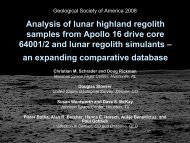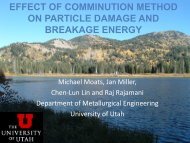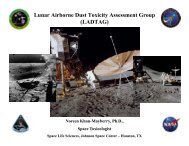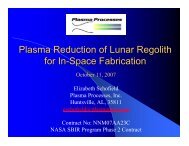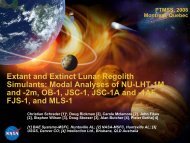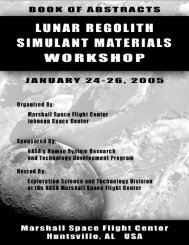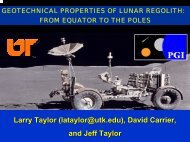Pilot Sample NU-LHT-1M
Pilot Sample NU-LHT-1M
Pilot Sample NU-LHT-1M
Create successful ePaper yourself
Turn your PDF publications into a flip-book with our unique Google optimized e-Paper software.
<strong>Pilot</strong> <strong>Sample</strong> <strong>NU</strong>-<strong>LHT</strong>-<strong>1M</strong><br />
SEM/EDS reconnaissance<br />
Sue Wentworth<br />
ESC Group, JSC/ARES<br />
grain count spectra collected<br />
by John Lindsay
Preliminary SEM/EDS grain counts by John Lindsay<br />
Analyses were made using JEOL 5910LV SEM equipped with an IXRF EDS system.<br />
Initial SEM and EDS done<br />
by John Lindsay included<br />
preliminary random grain<br />
counts in four areas. Area 4<br />
is shown at left. Results of<br />
EDS survey (75 grains total)<br />
are below. Olivine and opx<br />
totals seem high based on<br />
further SEM work.<br />
grain abundances<br />
area 4<br />
plagioclase 41.3<br />
glass 38.7<br />
olivine 12.0<br />
orthopyroxene 6.7<br />
clinopyroxene tr<br />
Fe oxide 1.3
Typical spectra for phases in grain count (above);<br />
Fe oxide not shown.<br />
plagioclase (plag)<br />
glass<br />
olivine (ol)<br />
orthopyroxene (opx)
SEM/EDS on this and following pages: JEOL 6340F FE-SEM, by Sue Wentworth<br />
Backscattered electron (BSE) image of typical area:<br />
Most common phases in sample are plagioclase and glass. Olivine and orthopyrxene<br />
are also present (previous page). Other phases include rare clinopyroxene (cpx, below)<br />
and ilmenite.<br />
BSE<br />
glass shard<br />
plag<br />
brightness here is<br />
geometry effect<br />
cpx<br />
sjw
SEM<br />
Glass spherules are rare to isolated. This one is<br />
firmly attached to larger vesicular glass.<br />
Glass has Mg-rich highlands composition<br />
regardless of shape, and is homogeneous.<br />
No inclusions have been identified in glass.<br />
Nothing found in sample that looks like agglutinate.<br />
Found isolated ilmenite(), a Zr-rich grain, and a grain<br />
consisting of Si, Al, C, and O.<br />
O<br />
Si<br />
glass<br />
Al<br />
sjw<br />
Mg<br />
Na<br />
Ca<br />
O<br />
Si<br />
typical plagioclase<br />
Al<br />
Na<br />
Ca<br />
Glass constituents (in order of<br />
decreasing peak height, which<br />
qualitatively correlates to<br />
abundance ): O, Si, Al, Mg, Ca, Na,<br />
Fe.<br />
Composition is excellent<br />
approximation to those of many<br />
lunar highland impact glasses .
SEM: closer view of grain shown previously<br />
SEM closeup of spherule, left.<br />
sjw<br />
sjw<br />
Grain sizes:<br />
Full range of grain sizes is present.<br />
Small grains adhere to each other.<br />
Large grains have adhering tiny grains.<br />
Tiny grains seem to have same compositions<br />
as larger ones.<br />
<strong>Sample</strong> comments:<br />
<strong>Sample</strong> in jar is distinctly speckled black and white,<br />
unlike lunar soil, which would be dark gray.<br />
<strong>Sample</strong> does not behave like lunar soil during<br />
preparation; i.e., it does not adhere to scoop.


